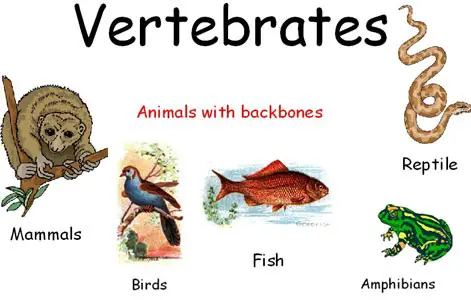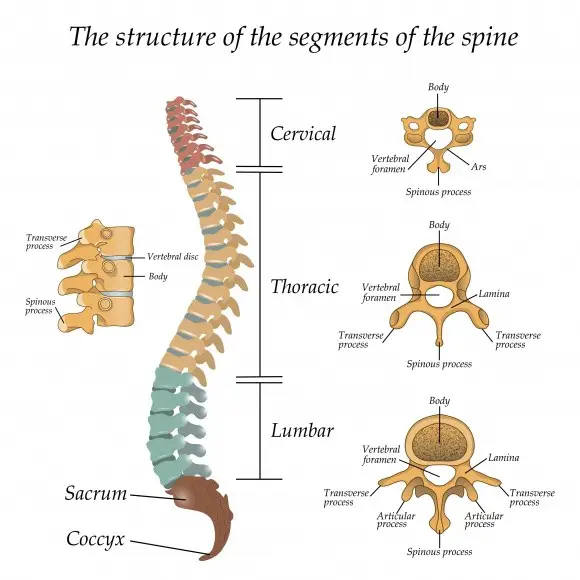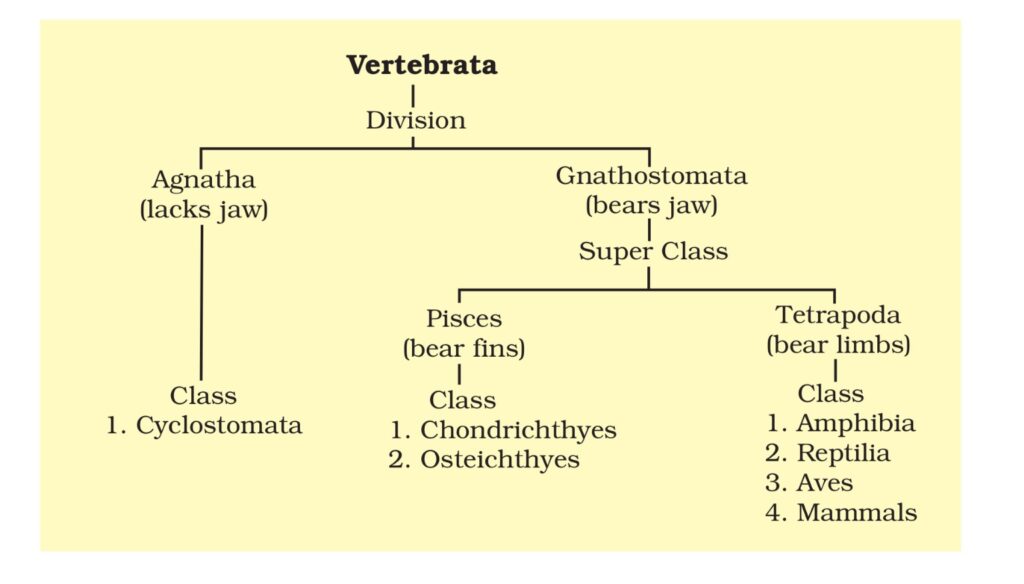Table of Contents
What is Vertebrate:
The vertebrates are a group of Chordata in which the notochord form the series of vertebrae, the vertebral column or backbone. The vertebral column is an important part of the axial skeleton in Subphylum Vertebrata, in Subphylum Vertebrata the brain box or cranium is also an important feature.
So we can say that the animals in which all the Chordata features are present throughout life or in certain stages of life plus the two important features, presence of skull and vertebral column present are known as Vertebrate.

Previously the term Chordata and Vertebrata was used interchangeably but as we know that the Vertebrate are a special kind of Chordata so we should not use the term Vertebrata and Chordata for similar meaning.
All the Vertebrates have all Chordata characters so we can call the Vertebrate as Chordata but in the nonvertebrate Chordata, the vertebral column and skull are absent so they can not be called as Vertebrate.
The members of phylum Chordata in which the skull remains absent are known as Protochordata collectively. The Protochordata include Subphylum Hemichordata, Urochordata and Cephaochordata are not Vertebrata. Subphylum Vertebrata and all the members of Protochordata together collectively known as Chordata.
General Characteristics of Subphylum Vertebrata:
If we talk about the fundamental characteristics of Subphylum Vertebrata then there is a total five-character that are not present in nonvertebrate, some of them may be present but all the five features are only present in Vertebrate.
The five fundamental features are, pharyngeal gill slits, dorsal hollow nerve cord, notochord these three characters are present in all Chordata, vertebral column, and skull, these five features are present in all Vertebrate but there are some other features which we list below.

- The earlier or lower Vertebrate like class Ostracodermi, Osteicthys, Chondricthys, Placodermi are aquatic. The higher Vertebrate like class Reptilia, class Aves, class Mammalia are terrestrial, class Amphibia perform both aquatic as well as terrestrial life.
- Metameric segmentation is present, body show bilateral symmetry.
- Due to presence of living growing endosketon, they show large size, small size also present, endosketon is made of cartilaginous tissues or bony tissue.
- Body is divided into head, trunk, post anal tail and neck, neck generally present in terrestrial Vertebrate.
- The paired appendages present in different form, in fish it form fin, in Amphibia it form forelimb hindlimb, in reptiles the paired appendages are redumentary, in Aves feathered wings present, in mammals forelimb and hindlimb present as paired appendages.
- Body is covered by different types of exoskeleton, like claw, nails, horns, hairs, dermal scales, epidermal scales or feathers.
- The body cavity represent true coelom, schizocoelic type of coelom present in which all visceral organs present.
- The notochord may be present in the same form throughout the life or maybe converted into vertebral column.
- The muscular system and the endoskeletal system together form the locomotive units which helps them to move from one place to another.
- Respiratory pigment maybe present or remain absent, respiration occur through gills in aquatic Vertebrate, through lungs in terrestrial Vertebrate.
- The blood vascular system is closed type with contractile muscular ventral heart. The heart is two, three or four chambered, the presence of hemoglobin in blood is a important feature.
- Nitrogenous excretory material is extracted from the body fluids with the help of paired mesonephric kidneys or metanephric kidneys.
- The nerve cord evolved into anterior enlarged complex brain and remaining slender spinal cord. The paired nerve arise from the brain and spinal cord are known as cranial nerve and spinal nerve respectively, the nerve have dorsal and ventral root separate.
- The nervous system control and co-ordinate among different parts of the body, along with nervous system endocrine system present in Vertebrate also take part in control and coordination. The endocrine system contain ductless endocrine glands and the secretion of endocrine glands are known as hormones, hormones are very important for proper control and coordination.
- Reproduction occur generally through sexual mode of reproduction, gonads are generally present in pairs (in birds only one ovary present). Development may be direct or indirect, fertilization internal or external.
Detailed Study On Characteristics Features of Subphylum Vertebrata
Diversity in Subphylum Vertebrata:
- The Subphylum Vertebrata not only important for its advanced features, number of species in Subphylum Vertebrata is around 49000. In the perspective of number of species Subphylum Vertebrata is top in all Subphylum of phylum Chordata, today only 40000 Vertebrate species are present remain become extinct.
- Subphylum Vertebrata show some unique features which are not present in other groups of animals, the flying ability of birds due to feathered wings is not common in all animals. Subphylum Vertebrata are popular due to their great adaptation power and they take part great role in ecosystem.
- They show great variation in size, the largest size is possible in Subphylum Vertebrata due to their growing living endoskeleton.
- They show great diversity in their habitat, some of them are aquatic, marine or freshwater, some of them live on trees, some spend most of the time in wind, some live in caves.
Detailed Study On Subphylum Vertebrata and its Diversity
Classification of Subphylum Vertebrata:
- Subphylum Vertebrata can be divided into two groups based on presence of jaw, group Agnatha and group Gnathostomata. Group Agatha do not have jaw in the mouth opening but in Gnathostomata the mouth opening is bordered by jaw.
- Group Agatha have two classes, class Ostracodermi and class Cyclostomata. Class Ostracodermi and Cyclostomata contain jawless fish like animals, members of class Ostracodermi are extinct while Cyclostomata present today as Hagfish and lamprey.
- Group Gnathostomata are classified into two superclasses based on the type of external paired appendages, superclass Pieces and superclass Tetrapoda. Superclass Pieces contain those Gnathostomata in which the fins present as paired appendages and in superclass Tetrapoda limbs present.
- Superclass Pieces divided into three classes, class Placodermi, Osteicthys and Chondricthys, Placodermi are armoured extinct fish. Class Osteicthys and class Chondricthys represent bony fishes and cartilaginous fishes respectively.
- Superclass Tetrapoda have four classes, class Reptilia, class Amphibia, Aves and class Mammalia in which the paired appendages are modified into different form for different purposes.

Detailed Study On An Overview of Classification in Subphylum Vertebrata
Phylogeny of Subphylum Vertebrata:
- Phylogeny is the evolutionary history of a group of animals, now we will focus on the phylogeny of Vertebrata.
- If we study carefully with the evidence we have we will find that in the evolutionary history fish come first, then Amphibia then reptiles, then from reptiles birds and mammals originate.
- The very first members of Vertebrate are unknown because there are no fossil evidence for the first Vertebrate.
- The first Vertebrate fossil evidence is of the period Ordovician but before Ordovician period vertebrate were present through we do not have any fossil evidence.
- The fossil evidence of Ordovician period was jawless fish like animal known as Ostracoderms, at present day they are extinct.
- Most of the workers believe that before Ordovician period during late Cambrian period vertebrate also present present, but there no fossil evidence for them. Some workers assume that they must be soft bodied so there are no chance for fossil formation or maybe they were freshwater habitant.
- Some fossil evidence say that true fishes come on our earth during Silurian period and in Devonian period they become peak so Devonian period also known as the Age of Fish.
- During carboniferous period some lobe fined fish come on land and evolved into Amphibia, Carboniferous period is known as the Age of Amphibia.
- In mesozoic era the primitive amphibians give rise to the primitive reptiles, during mesozoic era we can see the dinosaur and other reptiles in boom, mesozoic era is known as the Age of Reptiles.
- Coenozoic era is very important time period because this time mammals come on our earth and eventually reach at its peak level, this time is known as the Age of Mammals.
Detailed Study On Phylogeny of Subphylum Vertebrata

Detailed Study On Subphylum Vertebrata Definition Characteristics Classification Examples and Diagram
Hi Everyone!!! Welcome to Imaluop. Imaluop always try to learn some new and he want to share to other people. Here we will try to learn various topics on Science, specially on Biological Sciences.